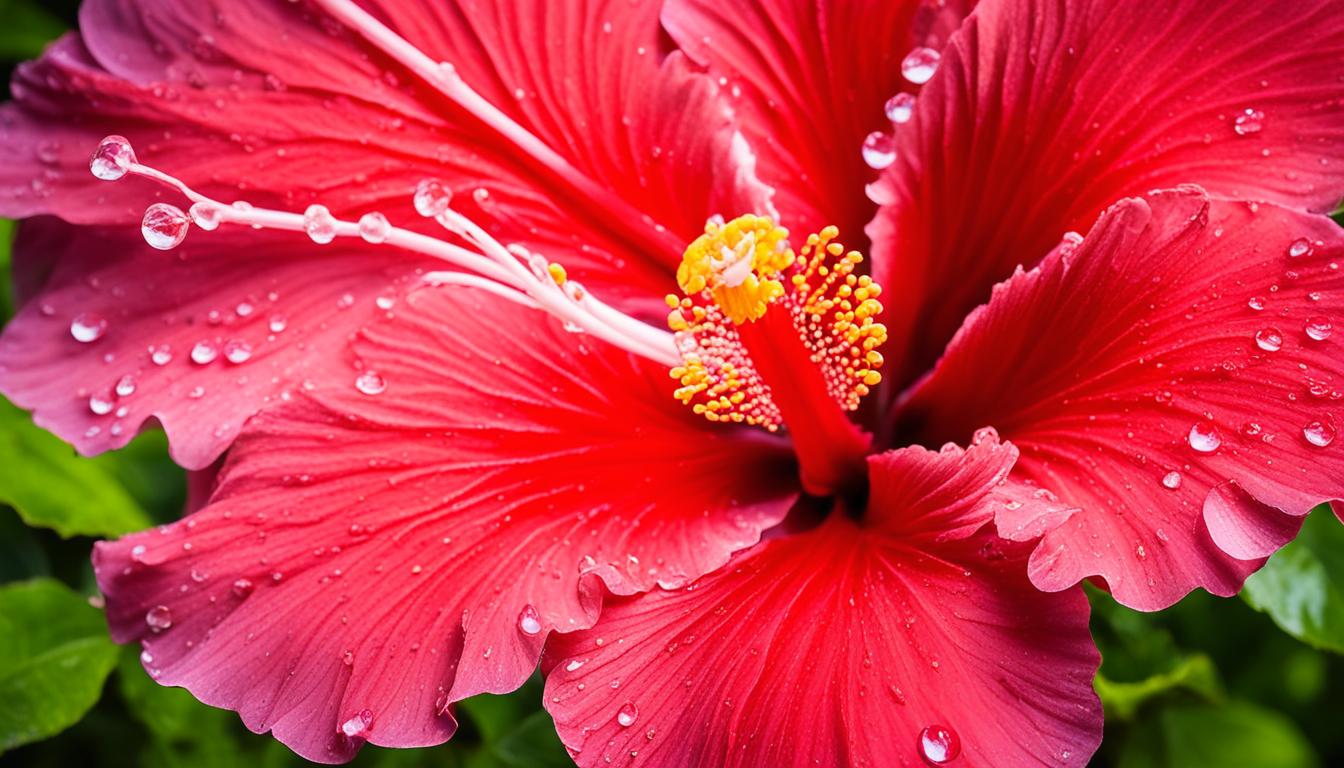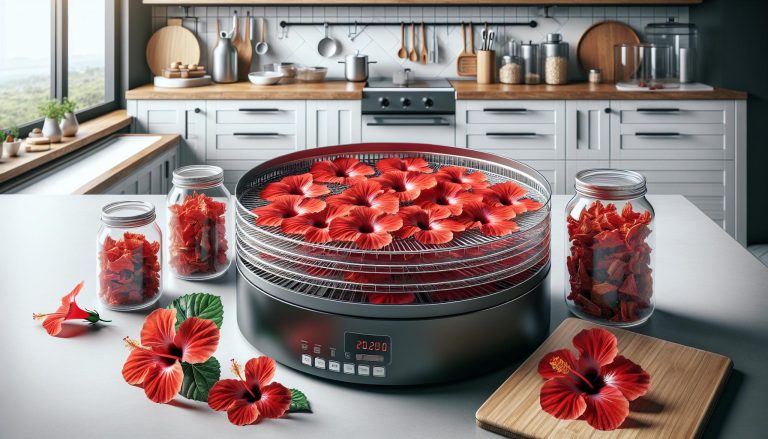Red Hibiscus Care Guide – Thriving Tips!
As I stroll through my garden, the vibrant red blooms of the hibiscus flowers catch my eye, instantly transporting me to a tropical paradise. The sight of these stunning red flowers brings me joy and reminds me of the warm summer days spent in exotic locations.
Growing red hibiscus plants in my garden has become a passion of mine. Their beauty and elegance add a touch of vibrancy to every landscape design. Whether you’re a seasoned gardener or just starting out, caring for red hibiscus is a rewarding experience that will bring life and color to your outdoor space.
Key Takeaways:
- Red hibiscus plants are a stunning addition to any garden or landscape design.
- Growing red hibiscus requires proper care and attention to thrive.
- By providing the right amount of water, sunlight, pruning, and fertilizer, you can ensure vibrant blooms throughout the growing season.
- Red hibiscus plants can be grown in containers or planted in garden beds.
- With the right care, hibiscus plants can bloom from spring until fall.
Hibiscus Care: Containers vs. Outdoor Planting
When it comes to hibiscus care, one important decision you’ll need to make is whether to grow your hibiscus in containers or plant them in garden beds outdoors. Both options have their advantages and considerations, so let’s take a closer look at each.
Growing Hibiscus in Containers
Growing hibiscus in containers offers several benefits. One major advantage is the ability to move the plant around to find the perfect spot that meets its sunlight and temperature requirements. This is especially useful if you live in an area with fluctuating weather conditions or limited outdoor space.
- Choose a slightly smaller container for your hibiscus, allowing room for the roots to grow. Ensure the container has good drainage to prevent waterlogging.
- Optimal soil for hibiscus in containers is well-draining and enriched with organic matter.
- Regularly check the moisture levels of the soil in the container and water accordingly. Container-grown hibiscus may require daily watering, especially in hot weather.
With container gardening, you can also protect your hibiscus from certain pests and diseases, as well as move it indoors during colder months or extreme weather conditions.
Outdoor Planting
If you prefer to plant your hibiscus directly in garden beds, there are a few factors to consider. Spacing is crucial to ensure adequate air circulation and room for the plant to grow. Space hibiscus plants about 2-3 feet apart to allow them to flourish.
Hibiscus plants thrive in slightly acidic soil with good drainage. Prepare the soil by incorporating organic matter and ensuring it is well-draining. Amend the soil composition if it is too alkaline to meet the acidic requirements of hibiscus plants.
Outdoor planting allows hibiscus plants to establish deeper root systems and can provide a lush, natural aesthetic to your garden or landscape design.
Whether you choose to grow hibiscus in containers or plant them in garden beds, providing the right care and conditions will help your hibiscus plants thrive and contribute to a vibrant and colorful outdoor space.
Hibiscus Care: Water and Sunlight
Proper watering and sunlight are crucial for the health of hibiscus plants. To ensure optimal growth and vibrant blooms, it is important to pay attention to their watering needs and sunlight requirements.
Watering Hibiscus
When it comes to watering hibiscus plants, remember that consistency is key. Container hibiscus plants should be watered daily, while outdoor hibiscus plants should be watered every other day. Watering hibiscus plants with warm water is recommended, as cold water can shock them.
Sunlight Requirements
Hibiscus plants thrive in full sun, so it’s important to provide them with at least 8 hours of direct sunlight per day. Be mindful of the positioning of your hibiscus plants to ensure they receive adequate sunlight throughout the day.
Now that you know the importance of proper watering and sunlight for hibiscus care, let’s move on to other essential aspects of growing and caring for these beautiful flowers.
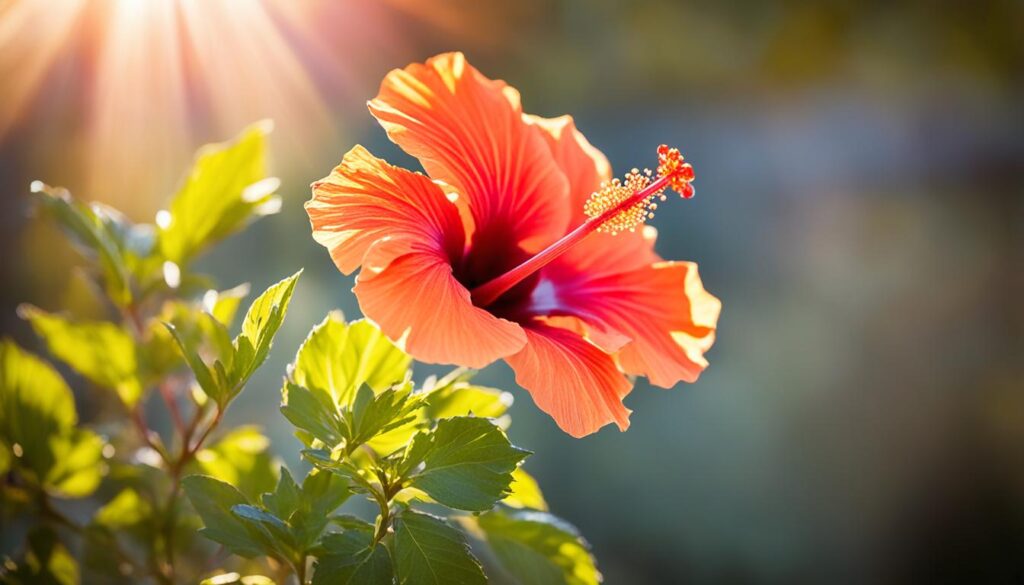
Hibiscus Care Essentials
- Choose a well-draining pot or garden bed with nutrient-rich soil.
- Prune hibiscus plants to promote healthy growth and remove weak branches.
- Monitor for pests and diseases regularly, and take appropriate action when necessary.
- Fertilize hibiscus plants with a balanced fertilizer according to the recommended schedule.
| Hibiscus Care Tips | Watering | Sunlight |
|---|---|---|
| Container Hibiscus | Water daily | At least 8 hours of direct sunlight per day |
| Outdoor Hibiscus | Water every other day | At least 8 hours of direct sunlight per day |
Hibiscus Care: Extra Tips
In addition to the basic care requirements for hibiscus plants, there are a few extra tips that can ensure their optimal health and vibrant blooms.
Pest Control
Hibiscus plants are susceptible to pests such as aphids, spider mites, and whiteflies. Regular monitoring is essential to catch infestations early. To treat pests, use insecticidal soap solutions, which are safe and effective. Apply the soap solution according to the package instructions, ensuring thorough coverage of the plant.
Pruning Techniques
Pruning hibiscus plants in the spring is crucial for promoting future blooms. Focus on removing weak or outward-jutting branches to encourage stronger growth and a compact shape. Prune just above a leaf node or bud to stimulate new growth. Avoid excessive pruning, as it may delay flowering.
Managing Yellow Leaves
If you notice yellow leaves on your hibiscus plant, it could be a sign of overwatering. Reduce the frequency of watering to prevent waterlogged roots. Adjust the watering schedule based on the plant’s needs and the moisture level of the soil. Proper drainage is essential for the health of hibiscus plants.
Potting Materials
When choosing pots for your hibiscus plants, opt for plastic or stone containers instead of clay. Clay pots can contribute to soil alkalinity, which hibiscus plants are sensitive to. Plastic or stone pots provide better drainage and help maintain ideal soil pH levels.
To further enhance your understanding of hibiscus care, take a look at the table below:
| Hibiscus Care Tips | Details |
|---|---|
| Pest Control | Monitor for common pests like aphids, spider mites, and whiteflies. Treat with insecticidal soap solutions. |
| Pruning Techniques | Prune hibiscus in the spring to promote future blooms and remove weak branches. Prune just above a leaf node or bud. |
| Managing Yellow Leaves | If leaves turn yellow, reduce watering to prevent overwatering. Ensure proper drainage to prevent waterlogged roots. |
| Potting Materials | Choose plastic or stone pots instead of clay pots to avoid soil alkalinity. Plastic or stone pots provide better drainage. |
By following these extra tips, you can ensure your hibiscus plants remain healthy, pest-free, and blooming beautifully throughout the season.
Plant Specifications
Hibiscus rosa-sinensis, also known as the Red Hibiscus, is the specific species focused on in this care sheet. It is a vigorous grower known for its beautiful flowers, ranging in size from 2 to 10 inches in diameter.
Hibiscus plants can grow as large shrubs, reaching heights of 4-10 feet and widths of 3-6 feet. With their impressive size and vibrant blooms, they make a bold statement in any garden or landscaping design.
These perennial plants feature glossy evergreen foliage and come in a variety of colors, including red, pink, orange, yellow, and white. Their showstopping flowers attract butterflies and hummingbirds, adding life and movement to your outdoor space.
Whether you choose to grow hibiscus plants in containers or use them as landscaping elements, their striking presence and ability to thrive in various conditions make them a popular choice among gardeners and horticulture enthusiasts.
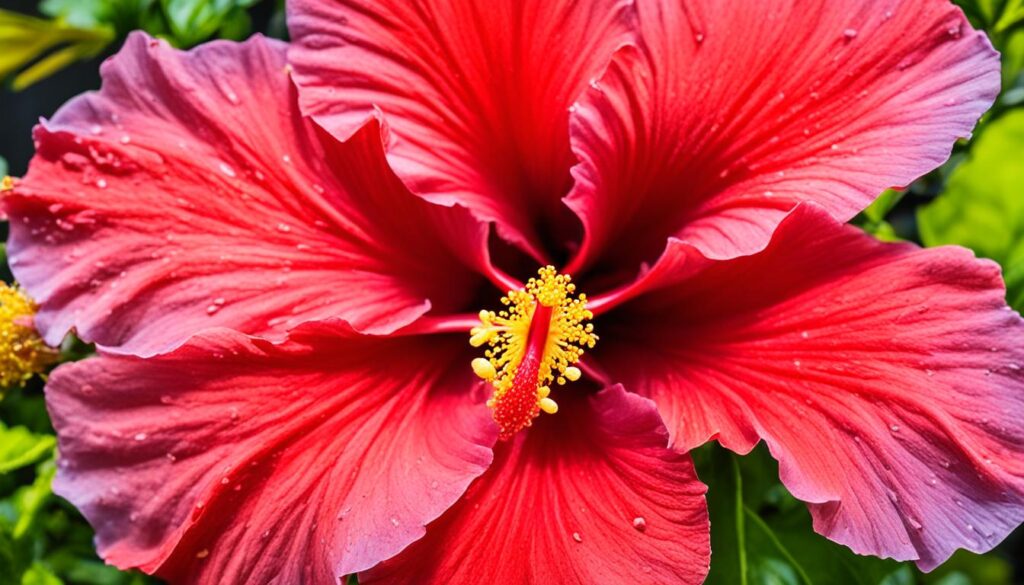
Key Points:
- Hibiscus rosa-sinensis is a vigorous grower with beautiful flowers ranging from 2 to 10 inches in diameter.
- These plants can grow as large shrubs, reaching heights of 4-10 feet and widths of 3-6 feet.
- They have glossy evergreen foliage and come in a variety of colors, making them a vibrant addition to any garden or landscape.
- Hibiscus plants can be grown in containers or used for landscaping purposes, offering versatility in design options.
Light
Hibiscus plants thrive when they receive the right amount of sunlight. They prefer full sun, so it’s best to plant them in an area that receives at least 8 hours of direct sunlight per day. This is especially important in northern climates where the sun can be less intense.
In southern climates, where the sun can be stronger, hibiscus plants can tolerate light shade. This means they can be planted in areas with filtered sunlight, such as under the canopy of a larger tree or in the shadow of a building. This helps to protect the plants from the scorching heat of the sun.
Choosing the Right Sunlight Exposure
When deciding where to plant your hibiscus, consider the climate and the intensity of the sun. In northern climates, full sun exposure is essential for the plants to thrive and produce vibrant blooms. In contrast, plants grown in southern climates may benefit from some protection from the intense sunlight.
By understanding the specific light requirements of your hibiscus plants, you can ensure that they receive the optimal amount of sunlight for their growth and blooming.
Pruning
Proper pruning is essential for maintaining the health and appearance of hibiscus plants. By shaping and trimming the plant, you can encourage new growth and ensure a beautiful display of vibrant blooms. Timing is crucial, with spring being the best season for pruning hibiscus plants.
Hardy hibiscus plants should be pruned by about half to stimulate growth and rejuvenation. This involves cutting back the plant’s branches and removing any weak or inward-growing stems. By doing so, you allow for better airflow and light penetration, promoting overall plant health and vigor.
Potted hibiscus plants, especially those grown in containers, may require more frequent and lighter pruning throughout the year. This involves removing spent flowers, dead or diseased branches, and thinning out crowded areas to maintain a compact and aesthetic shape.
It’s important to note that pruning at any time of the year will not completely stop flowering, but it may delay the blooming process. Therefore, it’s advisable to prune hibiscus plants in the spring to allow sufficient time for new growth and bud formation.
When pruning your hibiscus plants, be sure to use clean and sharp pruning shears or scissors to make clean cuts without causing damage to the plant. Additionally, consider applying a mild disinfectant to the tools before and after pruning to prevent the spread of any potential diseases or pests.
Benefits of Pruning Hibiscus Plants:
- Encourages new growth and rejuvenation
- Enhances airflow and light penetration
- Maintains compact and aesthetic shape
- Removes dead or diseased branches
- Prevents overcrowding
In order to visualize the pruning process and understand the different cuts involved, refer to the following table:
| Pruning Techniques | Description |
|---|---|
| Hard Pruning | Cutting back hardy hibiscus plants by about half to stimulate growth and rejuvenation. |
| Light Pruning | Frequent and lighter pruning throughout the year, mainly focused on removing spent flowers, dead or diseased branches, and thinning out crowded areas. |
Remember, proper pruning techniques play a vital role in the overall health and appearance of your hibiscus plants. By following these guidelines and ensuring your plants receive adequate care, you can enjoy a stunning display of vibrant blooms throughout the growing season.
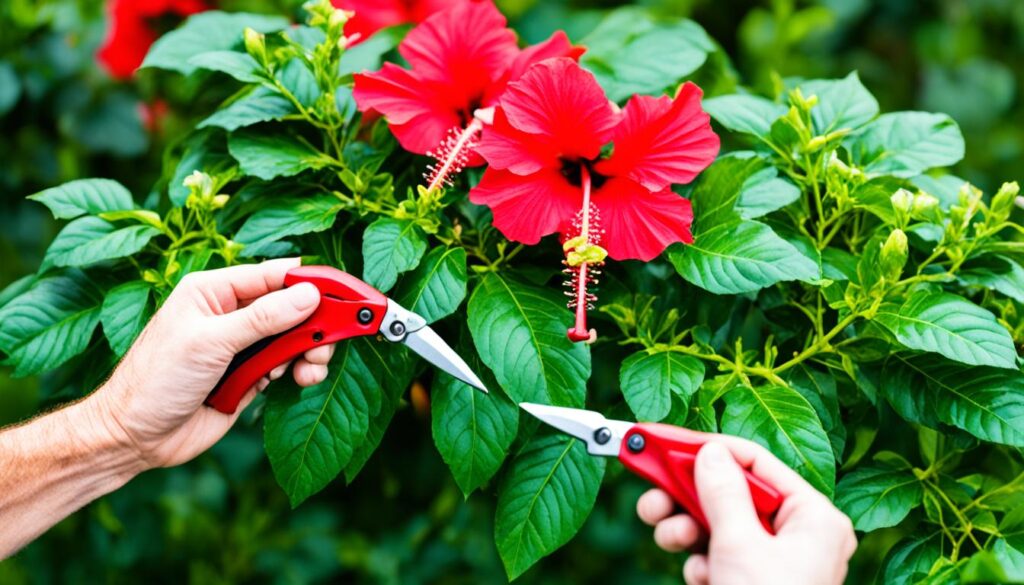
Water
Proper watering is essential for the healthy growth of hibiscus plants. These tropical beauties thrive in consistently moist soil with good drainage. Here’s what you need to know about watering your hibiscus:
Moist Soil
Hibiscus plants prefer soil that is moist but not waterlogged. This means you should aim to keep the soil evenly damp, avoiding both drought conditions and excessive moisture.
Supplemental Watering
Newly planted hibiscus plants may require supplemental watering until they establish their root system. Monitor the soil moisture and water as needed, ensuring the plant receives enough hydration to promote healthy growth.
Container Plants
If you’re growing your hibiscus in a container, it’s important to check the soil moisture daily. Container plants tend to dry out faster than those planted in the ground, so regular attention is necessary to prevent dehydration.
Outdoor Plants
For hibiscus plants planted in garden beds, water them every other day to maintain the desired moisture level. Adjust the frequency based on the weather conditions and the moisture retention of the soil.
Drainage
Good drainage is crucial for hibiscus plants. Ensure that the planting area or container has adequate drainage holes to allow excess water to escape. This helps prevent waterlogged roots and potential rot.
Remember, overwatering can be detrimental to hibiscus plants. Be mindful of their watering needs to create a healthy and thriving environment for these stunning tropical blooms.
Hardiness
Hibiscus plants exhibit varying levels of hardiness based on their species. Understanding the temperature tolerance and overwintering needs of hibiscus can help ensure their survival and vibrant growth in different climates.
Tropical Hibiscus
Tropical hibiscus plants, known for their colorful blooms, thrive in warm climates. They prefer temperatures above 50°F (10°C) and are commonly grown in regions with mild winters. These stunning beauties are a perfect addition to tropical gardens and landscapes.
Hardy Hibiscus
Hardy hibiscus, also known as rose mallow, are cold-tolerant varieties that can withstand temperatures as low as -30°F (-34°C). These hibiscus plants are suitable for cooler climates and are resilient enough to survive frosty winters. With their large, showy flowers, hardy hibiscus adds a touch of elegance to any garden.
In regions where the mercury plunges significantly lower, overwintering container-grown hibiscus plants becomes necessary. This practice entails protecting the plants from freezing temperatures while they are temporarily sheltered indoors. With proper care, overwintered hibiscus plants can continue to thrive and grace the garden with their beauty year after year.
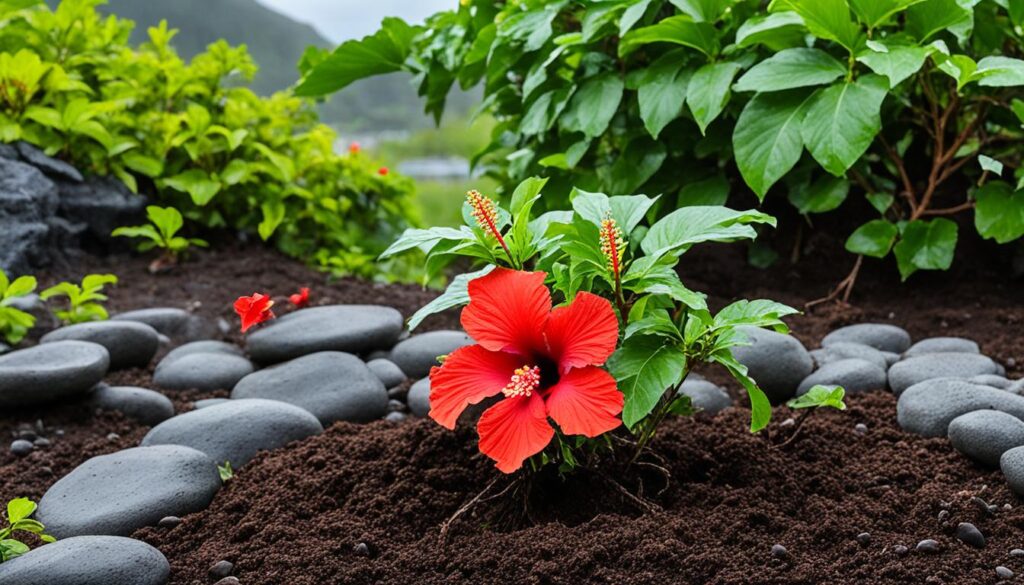
Overwintering
Overwintering tropical hibiscus plants is essential to protect them from the cold temperatures of winter. With proper indoor care, these vibrant plants can thrive and continue to brighten your home. Follow these steps to ensure a successful hibiscus overwintering process:
1. Find a Warm Indoor Spot
Choose a warm location in your home where your hibiscus can receive indirect sunlight. A sunny window sill or a heated room is ideal. Avoid placing your hibiscus near drafts or heating vents, as extreme temperature fluctuations can be detrimental.
2. Prune the Plant
Prior to bringing your hibiscus indoors, give it a thorough pruning. Remove any dead or damaged branches, as well as any leggy growth. Pruning helps maintain a compact shape and encourages healthy new growth in the spring.
3. Inspect for Pests
Before bringing your hibiscus indoors, carefully inspect the plant for any signs of pests such as aphids, spider mites, or whiteflies. If you notice any pests, treat the plant with an appropriate insecticidal soap or consult with your local nursery for recommended pest control methods.
4. Reduce Watering
During the cooler months, hibiscus plants go into a dormant state and require less water. Reduce your watering frequency and allow the soil to dry out slightly between waterings. Overwatering can lead to root rot and other problems.
5. Maintain Regular Pruning
While your hibiscus is indoors, continue to prune regularly to remove any leggy growth or dead branches. This will help maintain a compact shape and promote healthy growth when spring arrives.
6. Monitor for Signs of Stress
Keep a close eye on your hibiscus plant throughout the winter months. Look for any signs of stress, such as yellowing leaves or insect infestations. Address these issues promptly to ensure the health and vitality of your plant.
| Overwintering Tips for Hibiscus | Actions |
|---|---|
| Find a warm indoor spot | Choose an area with indirect sunlight, away from drafts or heating vents. |
| Prune the plant | Remove dead or damaged branches and shape the plant. |
| Inspect for pests | Check the plant for any signs of pests and treat accordingly. |
| Reduce watering | Water less frequently, allowing the soil to dry out between waterings. |
| Maintain regular pruning | Continuously prune to promote a compact shape and healthy growth. |
| Monitor for signs of stress | Watch for yellowing leaves or insect infestations and address promptly. |
Fertilizer
Hibiscus plants require regular fertilization to support their growth and blooming, especially if they are grown in containers. Fertilizers provide essential nutrients that hibiscus plants need to thrive and produce vibrant flowers. Let’s explore some effective fertilization strategies for your hibiscus plants.
Slow-Release Fertilizers
Slow-release fertilizers are an excellent option for ongoing feeding of hibiscus plants. These fertilizers release nutrients gradually over time, providing a steady supply of essential elements. They are convenient to use as they require less frequent applications compared to traditional fertilizers, reducing the risk of over-fertilization.
Liquid Fertilizers
Liquid fertilizers can be used to supplement the nutritional needs of your hibiscus plants. Look for liquid fertilizers with a high middle number (phosphorus) in their N-P-K ratio. Phosphorus promotes strong root development and abundant blooms. Follow the manufacturer’s instructions for application rates and frequency to ensure optimal results.
Nutrient Supplementation
In addition to regular fertilization, hibiscus plants may benefit from nutrient supplementation, particularly iron. Iron is an essential micronutrient that hibiscus plants need for healthy growth and vibrant foliage. If your hibiscus plants show signs of iron deficiency, such as yellowing leaves with green veins, consider providing them with an iron supplement to address the nutrient imbalance.
It’s important to note that fertilizing needs may vary depending on the time of year and growth stage of your hibiscus plants. As the plants enter dormancy during the winter months or while overwintering, fertilizing can be reduced to avoid stimulating new growth. Always follow the instructions provided with the fertilizer product and monitor your plants for any signs of nutrient deficiencies or excesses.
 Investing in the right fertilizer and providing proper nutrient supplementation can greatly enhance the health and vibrancy of your hibiscus plants. Remember to fertilize regularly, choose appropriate slow-release or liquid fertilizers, and address any nutrient deficiencies promptly. Your hibiscus plants will reward you with stunning blooms that will elevate the beauty of your garden.
Investing in the right fertilizer and providing proper nutrient supplementation can greatly enhance the health and vibrancy of your hibiscus plants. Remember to fertilize regularly, choose appropriate slow-release or liquid fertilizers, and address any nutrient deficiencies promptly. Your hibiscus plants will reward you with stunning blooms that will elevate the beauty of your garden.
Pests and Diseases
Hibiscus plants, like any other plants, are susceptible to various pests and diseases that can affect their health and overall growth. It is essential for gardeners and hibiscus enthusiasts to be aware of these potential problems and take preventive measures to ensure the well-being of their plants.
Common Pests
A number of pests can infest hibiscus plants, causing damage to leaves, stems, and flowers. Some common pests that hibiscus plants may encounter include:
- Aphids
- Thrips
- Spider mites
- Whiteflies
- Scale insects
- Mealybugs
These pests can weaken the plant and hinder its growth. Regular scouting and the use of beneficial insects can help control pest infestations naturally and reduce the need for chemical interventions.
Common Diseases
In addition to pests, hibiscus plants are also susceptible to various diseases. Common hibiscus diseases include:
- Powdery mildew
- Downy mildew
- Botrytis
Powdery mildew and downy mildew are fungal diseases that can cause white or grayish powdery patches on the leaves, while botrytis is a fungal disease that causes brown spots and decay on leaves and flowers. Adequate air circulation, proper watering, and avoiding overcrowding can help prevent these diseases.
Identification and Treatment
Proper identification of pests and diseases is crucial for effective treatment. If you notice any unusual spots, discoloration, or signs of infestation, it is recommended to reach out to local extension agencies or horticulturists for accurate identification and treatment recommendations.
Conclusion
Proper care and attention to the needs of red hibiscus plants can result in vibrant blooms throughout the growing season. Whether grown in containers or in garden beds, with the right amount of water, sunlight, pruning, and fertilizer, hibiscus plants can thrive and enhance any garden or landscape design.
Red hibiscus care is essential for maintaining healthy plants and ensuring the best blooming potential. By providing adequate water and sunlight, regularly pruning for shape and growth promotion, and fertilizing to provide necessary nutrients, you can create a stunning hibiscus garden. Whether you choose to incorporate hibiscus plants in containers or use them to landscape your outdoor space, their vibrant blooms will undoubtedly add a pop of color and beauty to your surroundings.
Remember to choose the right potting materials for your hibiscus plants and be mindful of their specific growing conditions. Regularly monitor for pests and diseases and take appropriate measures to prevent and treat them. By following these red hibiscus care tips, you can enjoy the stunning blooms and create a captivating garden that will be the envy of all.

